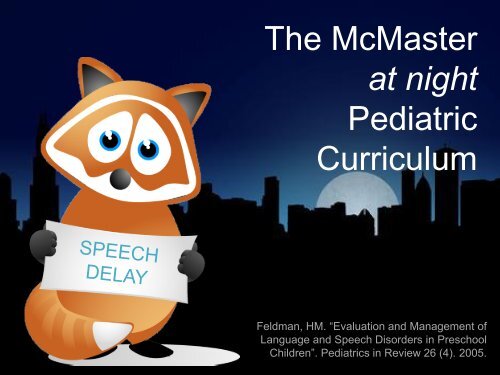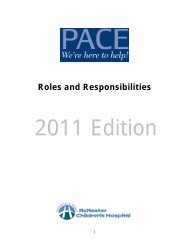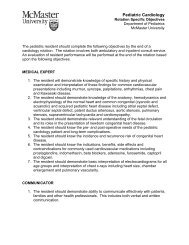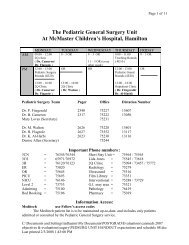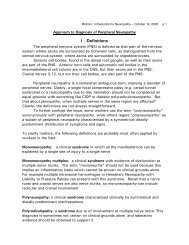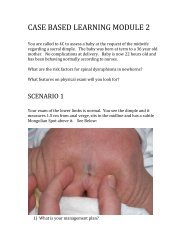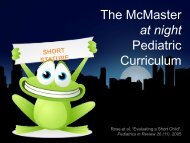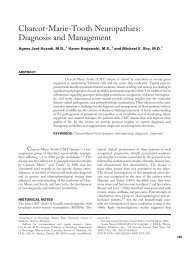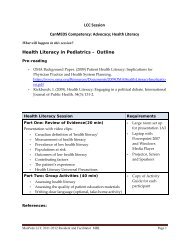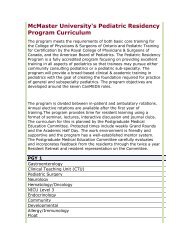Approach to Speech Delay
Approach to Speech Delay
Approach to Speech Delay
Create successful ePaper yourself
Turn your PDF publications into a flip-book with our unique Google optimized e-Paper software.
The McMasterat nightPediatricCurriculumFeldman, HM. “Evaluation and Management ofLanguage and <strong>Speech</strong> Disorders in PreschoolChildren”. Pediatrics in Review 26 (4). 2005.
Objectives• Describe normal language and speech development, andrecognize abnormalities that require referral• Generate a differential diagnosis for language and speechdelay in a preschool child• Differentiate specific language impairment from globaldelays and autism• Evaluate the effectiveness of treatment for language andspeech delay
Background• Language: the expression of human communicationthrough which ideas and information can be shared• Receptive language: the ability <strong>to</strong> understand• Expressive language: the ability <strong>to</strong> produce• <strong>Speech</strong>: manifestation of language that uses vocal sound,requiring a complex interaction of cortical, mo<strong>to</strong>r,respira<strong>to</strong>ry, laryngeal and oral systems• 10-15% of 2-year-olds are diagnosed with speech delay,and over half will “catch up” by 3 years
Normal Miles<strong>to</strong>nesAge Receptive Expressive0-2 months Turns <strong>to</strong> soundPrefers voicesInterested in facesCries2-4 months Coos6 months Responds <strong>to</strong> name Babbles9 months Understands verbal routines Points12 months Follows a verbal command JargonFirst words15 months Points <strong>to</strong> body parts by name Learning new words slowly10-20 words18-24 months Understands sentences Learning new words quickly50-100 wordsUses two-word phrases
Normal Miles<strong>to</strong>nesAge Receptive Expressive24-36 months Answers questionsFollows two-step commands36-48 months Understands much of what issaid48-60 months Understands much of what issaid, commensurate withcognitive levelUses three-word phrasesAsks “what” questions50% intelligibleAsks “why” questions75% intelligibleCreates well-formed sentencesTells s<strong>to</strong>ries100% intelligible6 years Pronounces most speech soundscorrectlyMay still have difficulty with “sh”,“th”, “s”, “z”, “r”, “l”7 years Pronounces speech soundscorrectly including consonantblends
Test Your Knowledge• Which of the following children would you refer for furtherevaluation of speech delay?A. 4-month-old who does not babbleB. 12-month-old with no single wordsC. 24-month-old with fewer than 50 wordsD. 48-month-old with dysfluency
The Answer• Like lab tests, the normal achievement of miles<strong>to</strong>nesoccurs within a range, and abnormal is defined by degreeof deviation from the mean• The average 12-month-old has a fewwords, but absence of words is not acause for concern until 15-18 months• A 24-month-old should have a rapidlyincreasing vocabulary of well over 100words• Dysfluency is normal in preschoolers
Indications for ReferralAgeAny ageFindingLack of response <strong>to</strong> soundLack of interest in interaction with peopleLoss of previous miles<strong>to</strong>nes4 months Lack of drive <strong>to</strong> communicate6-9 months Poor sound localization12 months No verbal routinesFailure <strong>to</strong> use mama, dada15-18 months No single wordsPoor understanding of language24 months Vocabulary less than 50 words or no two-word phrasesLess than 50% intelligible <strong>to</strong> strangers36 months Rote memorization or repetition onlyLess than 75% intelligible <strong>to</strong> strangers48 months Inability <strong>to</strong> participate in conversationStuttering
The Case• The parents of an 18-month old boy bring him <strong>to</strong> youroffice because they are concerned that he does not haveany words• He responds <strong>to</strong> his name and says “mama” and “dada”with meaning but otherwise communicates by crying,smiling, making vocalizations and pointing• He has been treated for two ear infections but otherwisehis medical his<strong>to</strong>ry, including perinatal his<strong>to</strong>ry, isunremarkable
His<strong>to</strong>ryWhat would you ask?
His<strong>to</strong>ry• Full his<strong>to</strong>ry of language development miles<strong>to</strong>nes• Determine if the delay is expressive alone• Does the child follow commands?• Complete developmental his<strong>to</strong>ry including• Gross mo<strong>to</strong>r• Fine mo<strong>to</strong>r• Social• Cognitive• The younger the child, the more challenging it is <strong>to</strong>differentiate cognitive from speech development
His<strong>to</strong>ry• The social development his<strong>to</strong>ry is critical• Does the child point <strong>to</strong> objects?• Is the child interested in communicating?• Does the child demonstrate reciprocity?• What is the nature of the child’s play?• Have any miles<strong>to</strong>nes ever been lost?• Ask for the results of any audiology tests and for theparents’ assessment of the child’s hearing• Does the child turn <strong>to</strong> sound or respond <strong>to</strong> his name?
His<strong>to</strong>ry• A thorough medical his<strong>to</strong>ry focusing on fac<strong>to</strong>rs that affectcognition (genetic disorders, prenatal exposures,prematurity, birth asphyxia, intracranial hemorrhage),hearing (meningitis, o<strong>to</strong><strong>to</strong>xic medications, chronic otitismedia), and mo<strong>to</strong>r development (CP, neuromusculardisorders)• Family his<strong>to</strong>ry of speech delay, delays in other domains,learning disabilities, hearing impairment, and geneticdisorders• It is essential <strong>to</strong> assess parents’ level of education,degree of concern, and access <strong>to</strong> social supports
Physical ExamWhat would you look for?
Physical Exam• Observe the child during the encounter includinginteractions with parents, interactions with strangers, andthe child at play• Does the his<strong>to</strong>ry match your assessment?• Look for growth abnormalities and dysmorphic features• Examine the skin for neurocutaneous stigmata• Perform a full neurological exam (adjusted for age)including cranial nerves, mo<strong>to</strong>r exam, and reflexes
Physical Exam• Inspect the external ear canals and tympanic membranesfor effusion• Examine the mouth and pharynx for malformations thatmay impact speech• Complete a full systemic exam <strong>to</strong> assess any potentialimpact of chronic disease on development
WorkupWhat would you order?
Workup• All children presenting with speech delay should haveformal audiology assessment regardless of whethernewborn hearing screen was passed• Further investigation is directed by his<strong>to</strong>ry, exam findings,and developmental stage• Children with some expressive language ability may bereferred for language, cognitive, or psychoeducationaltesting• Karyotype, chromosomal microarray, or specific genetictests may be indicated
Workup• In the case of abnormal neurological exam, brain MRImay rarely be indicated• Iron deficiency and lead poisoning contribute <strong>to</strong>developmental delay• Referral <strong>to</strong> a speech language pathologist for completeassessment is often warranted
Differential DiagnosisDevelopmental EtiologiesSpecificSpecific language impairmentReceptiveExpressiveMixedIntellecutal disability (global developmentaldelay)Articulation/phonologic disorderFluency disorder (stuttering)Verbal apraxiaSelective mutismPervasiveAutism spectrum disordersRett’s diseaseChildhood disintigrative disorderPervasive developmental disorder NOS
Differential DiagnosisOther E<strong>to</strong>logiesConditionHearing impairmentPrematurity and/or lowbirthweightGenetic conditionsNeurological conditionsMetabolic conditionsToxinsSocioeconomic fac<strong>to</strong>rsExamplesCongenital (genetic, TORCH) or acquired (medications,infections)Down syndrome, Fragile X, Williams, NF1, TSSeizures, cerebral palsy, brain malformations, headtrauma, intracranial hemorrhageMi<strong>to</strong>chodrial disease, PKU, hypothyroidism, irondeficiencyLead poisoningLack of language stimulation, low socioeconomic status,low parental education, neglect, parental depression, lackof permanency
Hearing Loss• Despite universal hearing screening for newborns inOntario, mild, progressive and acquired causes of hearingloss will be missed• The most common cause of mild hearing loss is chronicotitis media with effusion, however tympanos<strong>to</strong>my has nomore impact on speech and learning than watchful waiting• For sensorineural hearing loss, depending on severity,language therapy, cochlear implantation, and alternativeor augmentative methods of communication may besuccessful
Specific LanguageImpairment• Defined as receptive, expressive or mixed language delaywith solidly normal development in all other domains• Cognitive ability on non-language tasks is higher than onlanguage tasks• Generally responds well <strong>to</strong> therapy but some children willgo on <strong>to</strong> develop learning disabilities or behavioralproblems
Autism Spectrum Disorders• Pervasive developmental disorder characterized by:1. Impairment in social interaction• Poor non-verbal communication• Lack of peer relationships and reciprocity• Lack of shared attention2. Impairment in communication• <strong>Delay</strong>ed expressive language• Repetitive or sterotyped speech3. Restricted, repetitive, sterotyped behavior• Preoccupation with parts• Inflexible adherence <strong>to</strong> nonfunctional routine• Mo<strong>to</strong>r mannerisms• May have exaggerated responses <strong>to</strong> stimuli
Autism Spectrum Disorders• Prevalence is increasing but this may be due <strong>to</strong>awareness and diagnostic practices (estimated at 1/100-150 children, with males more affected)• Early detection of ASD is critical as some patients benefitfrom Applied Behavior Analysis especially when providedon an intensive basis• Prognosis is tied <strong>to</strong> IQ• May be a feature of other conditions such as DownSyndrome and Fragile X Syndrome
Test Your Knowledge• Of the following clinical features, which would the mostpredictive of future development of autism in your 18-month-old patient?A. Does not interact well with strangersB. Does not point <strong>to</strong> objectsC. Only engages in parallel play at daycareD. Has no words
The Answer• Pointing <strong>to</strong> objects normally appears at 9 months; lack ofshared attention, including pointing, is the strongestpredic<strong>to</strong>r of future development of autism• Toddlers normally have stranger anxietyso ask about reciprocity andcommunication with caregivers• Parallel play is the norm until age 2-3years• No words at 18 months is concerning butSLI is more likely than autism
The Social Environment• Children who have suffered from abuse or neglectcommonly have speech delay• Even under less extreme conditions, vocabulary size andmaturity of speech are associated with the quality andquantity of parental input• Reading <strong>to</strong> children interactively is the most effective way<strong>to</strong> expand vocabulary• Other strategies include limiting media exposure,repeating and expanding on a child’s verbal output, andlinking new words with gestures
Test Your Knowledge• The parents of a 5-year-old girl are very concerned thatshe has not spoken a word in JK since starting 2 monthsago. She speaks fully-intelligible complete sentences athome, and is otherwise well. What is the diagnosis?A. Verbal apraxiaB. Childhood disintegrative disorderC. Landau-Kleffner syndromeD. Selective mutism
The Answer• Selective mutism is a psychiatric disorder in which a childwho is capable of normal speech is unable <strong>to</strong> speak incertain situations, often with social anxiety• CDD involves a dramatic loss ofmiles<strong>to</strong>nes in all domains after 3-4 yearsof normal development• Verbal apraxia is a disorder of oromo<strong>to</strong>rspeech planning• Landau-Kleffner is a sleep-seizuredisorder causing subacute aphasia
Summary• Pediatricians have a central role in the detection,evaluation and management of children who have speechand language delay• A comprehensive developmental and medical his<strong>to</strong>ry isthe most important diagnostic <strong>to</strong>ol, which is supplementedby inven<strong>to</strong>ries and formal tests• At minimum, management includes audiologyassessment, speech language therapy for isolated delay,and comprehensive multidisciplinary treatment formultidimensional problems
Summary• For children with specific language impairment only, it isdifficult <strong>to</strong> predict who will improve• Though most children with specific language impairmentcatch up, all children are at risk for future academic andbehavioral disorders, and therefore require regular longtermfollow-up


